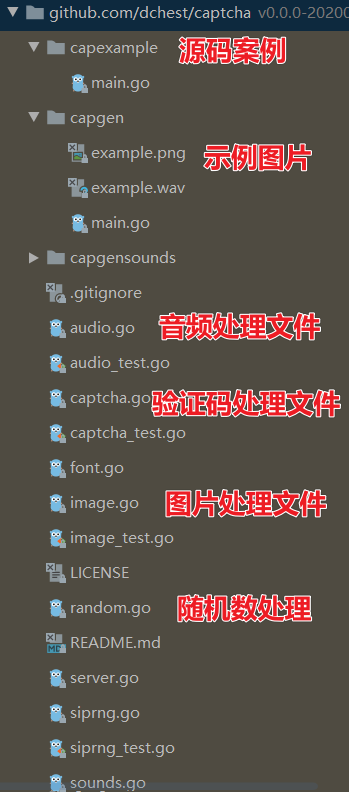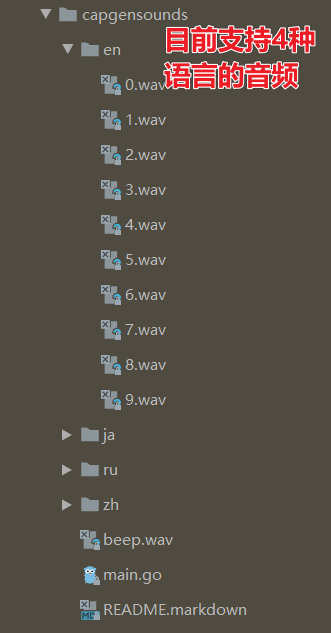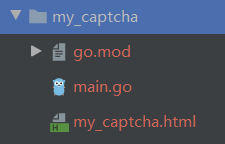我们用GO玩一下验证码
这是我参与更文挑战的第 21 天,活动详情查看: 更文挑战
我们用GO玩一下验证码
嗨,我是小魔童哪吒,咱们上次分享的GO 中 defer 的实现原理,再来回顾一下吧
- 分享了defer是什么
- 简单示意了栈和队列
- defer的数据结构和实现原理,具体的源码展示
- GO 中
defer的 3 条规则
要是对 GO 中 defer 实现原理还有点兴趣的话,欢迎查看文章 GO 中 defer的实现原理
今天我们来分享一些使用 GO 实现小案例,咱们边玩边成长

GO 的验证码介绍
我们平时使用到的验证码大致分为这几种,咱们梳理一下:
- 传统输入的形式
输入图片上的数字,文字,字母等等
- 输入类型的图形验证码
这个主要是来打广告的
- 纯行为验证码
例如,按照提示滑动等等
- 图标选择与行为辅助的验证码
例如咱们买火车票的时候验证码,各种图标让你选
- 点击式的图文验证与行为辅助
例如某宝的验证码
- 智能验证码
例如,点触智能验证码
GO 验证码案例
我们今天就来玩一玩第一种,使用最多的一种验证码吧
会使用 GO 的这个验证码库来完成,github.com/dchest/captcha
若我们向C/C++一样,将很多的底层处理都是我们自己来封装来实现的话,那还是挺累人的,GO 这一点确实蛮好,有很多使用的包,咱们在使用之余,也可以站在巨人的肩膀人,学习源码中的实现方式,学习大佬们的设计思想。

安装captcha库
大家使用如下命令就可以下载下来使用
go get github.com/dchest/captcha当我们在GOLAND 中用到 captcha库的时候,咱们可以看看源码目录
源码目录

- 有源码的具体使用案例
- 具体的示例图片
- 相关音频处理的实现
- 验证码处理的实现
- 图片处理的实现
- 随机数处理的实现方式
- 等等…
支持的语言

这个库目前支持的音频有 4 种语言:
- 英文
- 中文
- 俄文
- 日文
验证码默认参数
库中验证码的大小默认是 宽 240 px,高 80 px
在源码中的 image.go
const (
// Standard width and height of a captcha image.
StdWidth = 240
StdHeight = 80
// Maximum absolute skew factor of a single digit.
maxSkew = 0.7
// Number of background circles.
circleCount = 20
)
type Image struct {
*image.Paletted
numWidth int
numHeight int
dotSize int
rng siprng
}随机数包含的字符
如下是验证码id中允许的字符 ,可以在源码中看到
源码包中的 random.go
// idChars are characters allowed in captcha id.
var idChars = []byte("ABCDEFGHIJKLMNOPQRSTUVWXYZabcdefghijklmnopqrstuvwxyz0123456789")关于音频的处理
在源码的 sounds.go文件
目前对于音频只支持 4 种语言,"en", "ja", "ru", "zh".
/ NewAudio returns a new audio captcha with the given digits, where each digit
// must be in range 0-9. Digits are pronounced in the given language. If there
// are no sounds for the given language, English is used.
//
// Possible values for lang are "en", "ja", "ru", "zh".
func NewAudio(id string, digits []byte, lang string) *Audio {
a := new(Audio)
// Initialize PRNG.
a.rng.Seed(deriveSeed(audioSeedPurpose, id, digits))
if sounds, ok := digitSounds[lang]; ok {
a.digitSounds = sounds
} else {
a.digitSounds = digitSounds["en"]
}
numsnd := make([][]byte, len(digits))
nsdur := 0
for i, n := range digits {
snd := a.randomizedDigitSound(n)
nsdur += len(snd)
numsnd[i] = snd
}
// Random intervals between digits (including beginning).
intervals := make([]int, len(digits)+1)
intdur := 0
for i := range intervals {
dur := a.rng.Int(sampleRate, sampleRate*3) // 1 to 3 seconds
intdur += dur
intervals[i] = dur
}
// Generate background sound.
bg := a.makeBackgroundSound(a.longestDigitSndLen()*len(digits) + intdur)
// Create buffer and write audio to it.
sil := makeSilence(sampleRate / 5)
bufcap := 3*len(beepSound) + 2*len(sil) + len(bg) + len(endingBeepSound)
a.body = bytes.NewBuffer(make([]byte, 0, bufcap))
// Write prelude, three beeps.
a.body.Write(beepSound)
a.body.Write(sil)
a.body.Write(beepSound)
a.body.Write(sil)
a.body.Write(beepSound)
// Write digits.
pos := intervals[0]
for i, v := range numsnd {
mixSound(bg[pos:], v)
pos += len(v) + intervals[i+1]
}
a.body.Write(bg)
// Write ending (one beep).
a.body.Write(endingBeepSound)
return a
}其中关于语言的数据在digitSounds map 中
看到这个,就有点像做字库解析 和 嵌入式里面的数据解析了

var digitSounds = map[string][][]byte{
"en": [][]byte{
{ // 0
0x80, 0x7f, 0x80, 0x7f, 0x80, 0x80, 0x80, 0x7f, 0x80, 0x7f, 0x80,
...
},
"ru": [][]byte{
{ // 0
0x7f, 0x7f, 0x7e, 0x7f, 0x7f, 0x7e, 0x7f, 0x7e, 0x7f, 0x7f, 0x7e,
...
},
"zh": [][]byte{
{ // 0
0x7f, 0x80, 0x7f, 0x80, 0x80, 0x7f, 0x80, 0x7f, 0x80, 0x7f, 0x80,
...
},
"ja": [][]byte{
{ // 0
0x7f, 0x80, 0x7f, 0x80, 0x80, 0x80, 0x80, 0x80, 0x80, 0x80, 0x83,
...
}, 开始案例的演示

my_captcha.html 实现如下
暂时关于音频的语言,就写了2种语言
- 英文
- 中文
<!doctype html>
<head>
<title>GO 简单制作验证码案例</title>
<style>
input{
margin-top: 30px;
}
</style>
</head>
<body>
<script>
// 设置语言
function setSrcQuery(e, q) {
var src = e.src;
var p = src.indexOf('?');
if (p >= 0) {
src = src.substr(0, p);
}
e.src = src + "?" + q
}
// 播放音频
function playAudio() {
var le = document.getElementById("lang");
var lang = le.options[le.selectedIndex].value;
var e = document.getElementById('audio')
setSrcQuery(e, "lang=" + lang)
e.style.display = 'block';
e.autoplay = 'true';
return false;
}
// 切换语言
function changeLang() {
var e = document.getElementById('audio')
if (e.style.display == 'block') {
playAudio();
}
}
// 重新加载
function reload() {
setSrcQuery(document.getElementById('image'), "reload=" + (new Date()).getTime());
setSrcQuery(document.getElementById('audio'), (new Date()).getTime());
return false;
}
</script>
<div align="center" >
<select id="lang" onchange="changeLang()">
<option value="en">英文</option>
<option value="zh">中文</option>
</select>
</div>
<form action="/processCapcha" method=post align="center">
<p>请输入你在下面的图片中看到的数字:</p>
<p><img id=image src="/captcha/{{.CaptchaId}}.png" alt="Captcha image"></p>
<a href="#" onclick="reload()">重新加载</a> | <a href="#" onclick="playAudio()">播放音频验证码</a>
<audio id=audio controls style="display:none" src="/captcha/{{.CaptchaId}}.wav" preload=none>
You browser doesn't support audio.
<a href="/captcha/download/{{.CaptchaId}}.wav">下载文件</a> to play it in the external player.
</audio>
<input type=hidden name=captchaId value="{{.CaptchaId}}" align=center><br>
<input name=captchaSolution align=center>
<input type=submit value=Submit>
</form>main.go
- 展示验证码
- 处理验证码,结果展示
- 重载验证码
- 播放验证码音频
package main
import (
"github.com/dchest/captcha"
"io"
"io/ioutil"
"log"
"net/http"
"text/template"
)
const filePath = "./my_captcha.html"
// 读取 html 文件
func readHtml() string {
var bytes []byte
var err error
if bytes, err = ioutil.ReadFile(filePath); err != nil {
log.Fatalf("ioutil.ReadFile error filePath = %s , err :"+filePath, err)
return ""
}
return string(bytes)
}
// 读取html 文件,转成template.Template 指针
var formTemplate = template.Must(template.New("myCaptcha").Parse(readHtml()))
// 显示验证码
func showCaptcha(w http.ResponseWriter, r *http.Request) {
if r.URL.Path != "/" {
http.NotFound(w, r)
return
}
d := struct {
CaptchaId string
}{
captcha.New(),
}
// Execute将解析后的模板应用到指定的数据对象,并将输出写入wr
if err := formTemplate.Execute(w, &d); err != nil {
http.Error(w, err.Error(), http.StatusInternalServerError)
}
}
// 处理验证码,跳转结果页面
func resultPage(w http.ResponseWriter, r *http.Request) {
w.Header().Set("Content-Type", "text/html; charset=utf-8")
if !captcha.VerifyString(r.FormValue("captchaId"), r.FormValue("captchaSolution")) {
io.WriteString(w, "错误的验证码,请重新输入\n")
} else {
io.WriteString(w, "验证吗正确,你很棒哦!!\n")
}
io.WriteString(w, "<br><a href='/'>再试一下</a>")
}
func main() {
// 简单设置log参数
log.SetFlags(log.Lshortfile | log.LstdFlags)
http.HandleFunc("/", showCaptcha)
http.HandleFunc("/processCapcha", resultPage)
http.Handle("/captcha/", captcha.Server(captcha.StdWidth, captcha.StdHeight))
log.Println("starting server : 8888")
if err := http.ListenAndServe("localhost:8888", nil); err != nil {
log.Fatal(err)
}
}
上述代码的宽高 是这样的
StdWidth = 240
StdHeight = 80上述 HandleFunc 的回调函数是这个样子的,之前介绍 gin 的时候有分享过, 可以回头看看 文章 来我们一起探究一下net/http 的代码流程
// HandleFunc registers the handler function for the given pattern
// in the DefaultServeMux.
// The documentation for ServeMux explains how patterns are matched.
func HandleFunc(pattern string, handler func(ResponseWriter, *Request)) {
DefaultServeMux.HandleFunc(pattern, handler)
}验证码实际效果

点击播放音频验证码的时候,可以看到这样的效果

该音频,会根据我们选择语言,来播放不同的语音,读取图片上的数字

总结
- 验证码种类梳理
- 验证码库的安装
- 验证码库的源码介绍
- 实操,编码
- 验证码效果展示
欢迎点赞,关注,收藏
朋友们,你的支持和鼓励,是我坚持分享,提高质量的动力

好了,本次就到这里,下一次 如何使用GOLANG发送邮件
技术是开放的,我们的心态,更应是开放的。拥抱变化,向阳而生,努力向前行。
我是小魔童哪吒,欢迎点赞关注收藏,下次见~
本作品采用《CC 协议》,转载必须注明作者和本文链接



 关于 LearnKu
关于 LearnKu




推荐文章: